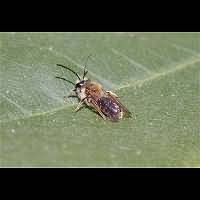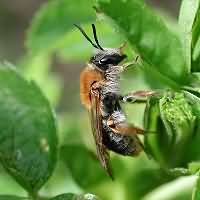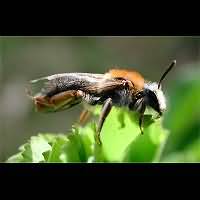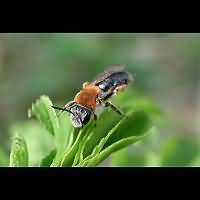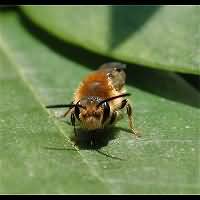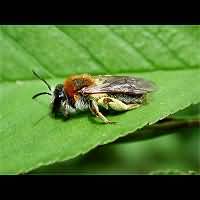[All pictures of garden wildlife on this page are thumbnails. Click on any thumbnail for a large format to be displayed.]

Early Mining Bee (Andrena haemorrhoa)
| Taxonomy | ||||||
|---|---|---|---|---|---|---|
| Kingdom: | Phylum: | Class: | Order: | Family: | Genus: | Species: |
| Animalia | Arthropoda | Insecta | Hymenoptera | Andrenidae | Andrena | A. haemorrhoa |
The Early Mining Bee is one of the earliest to be seen indeed. In 2002 we noticed the first one halfway March. It is a very common species, seen in many gardens as well. Due to it's unstriking features it flies about unnoticed and is therefore less frequently reported than it actually appears. It has the length of an average bee, some 8 to 11 mm. The thorax is foxy brown on top, the abdomen is black, except for the rear end, which is foxy brown again. The male is much smaller than the female is and its hairs are much lighter, tending to grey or even white. Thus it is very difficult to tell males apart from the males of other species. The Early Mining Bee is not a choosy animal at all: neither to the place it builds its nest, nor to the flowers it uses to feed on. Actually it benefits from human activities a lot. Females are often seen nesting alone, but groups of females do occur, even though these groups are never very big. It readily nests in gardens, play grounds, sportfields, paths and the sides of roads. Like in most mining bees only one generation is produced yearly, resulting in a short period of activity. Males can be seen in April and May only. Females may start earlier, as early as March and may still be seen in June. It is a common species all over Europe, including the British Isles.
In the top picture you see a male. The female is in all other pictures.

© Copyright 1998-2024 gardensafari.net (Hania Berdys)

 English / engels
English / engels  Dutch / nederlands
Dutch / nederlands